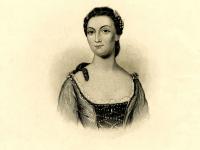During the 1700s, some women had active roles in the American Revolution and aided in the creation of a new nation. Even though women were not allowed to participate in the War as soldiers, women took action by boycotting British commodities such as tea, consequently hurting the British economy. Groups such as the Daughters of Liberty and Ladies Association of Philadelphia emerged from these oppositional tactics. Women, such as Esther Reed, raised money for the Continental Army, and her writings can be found in the Sentiments of an American Woman.
In Philadelphia, the introduction of literary salons created a sphere of influence for female writers. Poets such as Elizabeth Graeme Fergusson and Anna Young Smith used this space to develop their own voice. Their writings present the importance of women’s contributions for the Revolutionary cause. Elizabeth Graeme Fergusson held a literary salon in her own home, known as “Attic Evenings,” where she shared unconventional thoughts such as separating from her husband and placing women as equals to men in society. Even though her husband was a Loyalist, Fergusson supported the American cause in many ways. Anna Young Smith, Fergusson’s prodigy and niece, wrote on similar themes of women, politics, and marriage.
Women created all the primary sources used in this lesson, sources often excluded from the traditional narrative of the American Revolution. Exposing students to these literary works, therefore, provides a different perspective. In this lesson, students will engage with historical documents, such a poetry and journals, by examining the political and social dilemmas women faced. The documents created by Fergusson, Young, and Reed, help uncover a path for historical dialogue and challenge the traditional idea of a woman’s identity during the American Revolution.

